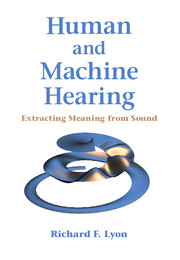Book contents
- Frontmatter
- Dedication
- Contents
- Foreword
- Preface
- Part I Sound Analysis and Representation Overview
- Part II Systems Theory for Hearing
- 6 Introduction to Linear Systems
- 7 Discrete-Time and Digital Systems
- 8 Resonators
- 9 Gammatone and Related Filters
- 10 Nonlinear Systems
- 11 Automatic Gain Control
- 12 Waves in Distributed Systems
- Part III The Auditory Periphery
- Part IV The Auditory Nervous System
- Part V Learning and Applications
- Bibliography
- Author Index
- Subject Index
- Plate section
8 - Resonators
from Part II - Systems Theory for Hearing
Published online by Cambridge University Press: 28 April 2017
- Frontmatter
- Dedication
- Contents
- Foreword
- Preface
- Part I Sound Analysis and Representation Overview
- Part II Systems Theory for Hearing
- 6 Introduction to Linear Systems
- 7 Discrete-Time and Digital Systems
- 8 Resonators
- 9 Gammatone and Related Filters
- 10 Nonlinear Systems
- 11 Automatic Gain Control
- 12 Waves in Distributed Systems
- Part III The Auditory Periphery
- Part IV The Auditory Nervous System
- Part V Learning and Applications
- Bibliography
- Author Index
- Subject Index
- Plate section
Summary
Another experiment should be adduced. Raise the dampers of a pianoforte so that all the strings can vibrate freely, then sing the vowel a in father, art, loudly to any note on the piano, directing the voice to the sounding-board of the piano; the sympathetic resonance of the strings distinctly re-echos the same a. On singing oe in toe, the same oe is re-echoed.
—On the Sensations of Tone, Hermann Ludwig F. Helmholtz (1863)In the classes of circuits discussed in the following chapters, the pole-zero patterns show at a glance the general form of the frequency characteristics with the important features placed clearly in evidence; they display the effects of varying the circuit parameters; and they reveal the key approximations that permit certain groups of complex circuits to be treated as equivalent circuits of less complexity.
—Pole-Zero Patterns: In the Analysis and Design of Low-order Systems, Angelo and Papoulis (1964)Bandpass Filters
Auditory filtering in the cochlea is generally conceptualized as bandpass filtering, with a dense array of filters representing up to thousands of locations along the cochlear partition. A bandpass filter is a system that responds strongly to frequency components within its passband, and only weakly to signals of other frequencies. This concept came up in the context of critical bands, and in the context of spectrum analysis; now we proceed to the mathematical description of the concept, building on what we learned about general linear systems in previous chapters.
We often refer to the peak of a bandpass filter; the peak frequency (or center frequency) and peak gain describe the point of highest gain, while the peak width and peak shape describe the frequency response of the passband, the high part of the frequency response close to that point. The parts of the frequency response further from the peak are often described as the skirt or tails of the bandpass response—often skirt if it drops rapidly, as a transition to a stopband, a range of frequencies in which the filter attenuates strongly, and tail if the frequency response levels off or drops slowly. This tail terminology appears to be unique to the hearing field, in which the low-frequency tails of tuning curves have long been recognized as functionally important (Kiang and Moxon, 1974).
- Type
- Chapter
- Information
- Human and Machine HearingExtracting Meaning from Sound, pp. 145 - 168Publisher: Cambridge University PressPrint publication year: 2017



